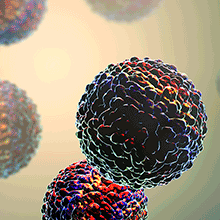The National Collection of Pathogenic Viruses – a dynamic repository for viral strains
Issue: SARS-CoV-2 and COVID-19
12 October 2021 article

The National Collection of Pathogenic Viruses (NCPV), established in 1999 with funding from the Wellcome Trust, curates and supplies pathogenic viruses to scientists around the world.
Operated by Public Health England (PHE) and based in Porton Down, UK, the collection includes Advisory Committee on Dangerous Pathogens (ACDP) hazard group 2 and 3 viruses, and viruses classified under the Specified Animal Pathogens Order (SAPO). All banks of viruses that are produced are independently cultured and authenticated. As a dynamic collection, new strains are regularly added to the catalogue and NCPV encourages deposits from scientists around the globe. Deposits are checked for identity, viability and contamination, stored in monitored cold storage and made available to the virology community for scientific use.
The importance and relevance of a viral repository that houses both modern and historical strains is of immense scientific value. Viruses can spend years circulating in obscurity and it is always difficult to predict which may become clinically significant. This was well illustrated during 2015–2016, when the Zika virus gained worldwide attention due to its links with microcephaly and other neurological disorders, resulting in the WHO declaring it a Public Health Emergency of International Concern. NCPV had within its existing catalogue a Zika strain from 1962, which had been isolated from Aedes africanus mosquitoes captured in Zika Forest, Uganda. This strain had been available to the scientific community since 2013 (NCPV 1308258v). In order to meet the growing public health demand, the NCPV catalogue was then rapidly updated to include a more recent clinical isolate, sourced from a semen sample and accompanied with rich metadata including full genomic sequence information (NCPV 1609021v). During the Zika outbreak, NCPV distributed live Zika or Zika RNA to 50 labs in 16 countries. These reference materials were essential for scientific research, underpinning a number of important studies that advanced our knowledge of the Zika virus. These ranged from NCPV Zika strains used to identify a small animal model suitable for in vivo Zika research, to comparing virulence differences between African and Asian Zika virus lineages, to methods for Zika virus inactivation. NCPV was also featured on a Brazilian TV show and in Focus science magazine (Italy) due to its provision of Zika reference materials and the importance of using authenticated viruses in research, respectively.
During the present SARS-CoV-2 pandemic, NCPV scientists have been supporting PHE’s outbreak response by monitoring the prevalence of SARS-CoV-2 antibodies in UK population sera, processing patient respiratory sample swabs, and testing vaccine and drug efficacy using plaque neutralisation assays. NCPV also accessioned and whole-genome sequenced the betacoronavirus OC43 (2008103v) and alphacoronaviruses 229E (2008101v and 0310051v) and NL63 (2008102v). NCPV is actively looking to access the betacoronavirus HKU-1 strain and would be interested in hearing from any virologists who would like to deposit this important strain within the collection. These seasonal human coronaviruses, related to SARS, MERS and SARS-CoV-2, are ADCP hazard group 2, and are currently being used worldwide in pandemic-response research (for example, in research to understand tissue tropism, dynamics and pathogenesis, and in assessing the specificity of rapid diagnostics and point-of-care tests). In addition, related viruses from NCPV have been used to investigate the broad antiviral activity of specific compounds and have been used in research conducted to support the SARS-CoV-2 outbreak responses.
In total, NCPV has over 300 catalogue items available on the Culture Collections website. Advantages to virologists looking to deposit into the collection include the ability to independently authenticate virus identity, sterility and mycoplasma testing, for which a Certificate of Analysis is provided. NCPV is certified to ISO 9001; shipping is compliant with global biosecurity regulations, and deposited viral strains are made available to scientists globally. Flexible release dates (for example ensuring the strain is only available after the publication of a given manuscript) are also available.
The value of biological resources such as NCPV to the scientific community is far reaching, and there is a recognised need for the conservation of organisms for future use. The importance of such collections is evidenced by the diversity and quality of the organisms and associated data they hold, the research they support and contribute to, the advances in industrial processes and biotechnology as a result of their use, as well as the role that they play in addressing global public health, societal and economic challenges.
As NCPV enters its third decade of operation and its parent organisation transfers from PHE to the United Kingdom Health Security Agency (UKHSA), it is anticipated that the collection will continue to expand to meet the ever-growing needs of the global virology community.
Further reading
Afrough B, Eakins J, Durley-White S, Dowall S, Findlay-Wilson S. X-ray inactivation of RNA viruses without loss of biological characteristics. Sci Rep 2020;10:21431.
Dowall SD, Graham VA, Rayner E, Atkinson B, Hall G et al. A susceptible mouse model for Zika virus infection. PLOS Negl Trop Dis 2016;10: e0004658.
Dowall SD, Graham VA, Rayner E, Hunter L, Atkinson B et al. Lineage-dependent differences in the disease progression of Zika virus infection in type-I interferon receptor knockout (A129) mice. PLOS Negl Trop Dis 2017;11:e0005704.
Emerson D, Wilson W. Giving microbial diversity a home. Nat Rev Microbiol 2009;7:758.
Kühnel D, Müller S, Pichotta A, Radomski KU, Volk A et al. Inactivation of Zika virus by solvent/detergent treatment of human plasma and other plasma-derived products and pasteurization of human serum albumin: inactivation of Zika in plasma derivatives. Transfusion 2016;57:802–810.
Milewska A, Chi Y, Szczepanski A, Barreto-Duran E, Dabrowska A et al. HTCC as a polymeric inhibitor of SARS-CoV-2 and MERS-CoV. J Virol 2021;95:e01622-20.
Smith D, McCluskey K, Stackebrandt E. Investment into the future of microbial resources: culture collection funding models and BRC business plans for biological resource centres. Springerplus 2014;3:81.

Ellie Drinkwater
NCPV Virologist

Dr Sarah Alexander
Lead Microbiologist
Connect with us
Twitter: @NCPV
Latest news: phe-culturecollections.org.uk/signup
Image: Dr_Microbe/iStock. Zika virus..
